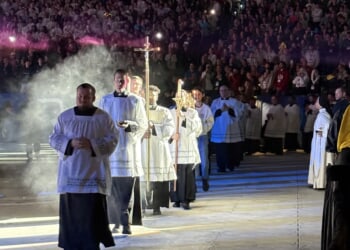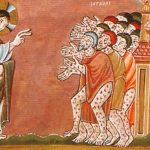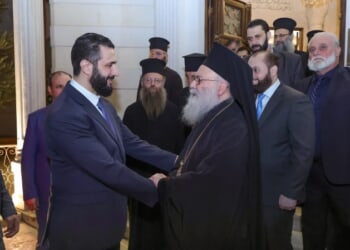I’ll never forget it. One of the most extraordinary assignments I had while working as a Papal Latinist was to write a Decretal Letter for no less than 522 martyrs killed during the Spanish Civil War. It was the largest single act of beatification in Church history.
Pope Francis wanted to draw attention to the charity these men, women, and children witnessed by giving up their lives, proving that Christian love cannot be doled out “in portions” but must imitate Christ’s “until the end.”
I spent countless hours painstakingly recording the names, birthdays, causes, and death dates of these extraordinary individuals. I wouldn’t be honest if I didn’t admit that it caused a good deal of suffering, but it was of the utmost importance that I make no mistake due to the eternal significance of such a pontifical act.
At a certain moment, my fingers dropped from the keyboard as I came across a Capuchin priest by the name of Fr. José Pérez González. I have no idea what Fr. José or his priestly ministry looked like. All I know is that I share a birthday with him on January 5th.
In an instant, it became clear to me that we venerate the saints not so much because they are different from us, but because we are like them. Fr. José must have had a set of parents and perhaps a few siblings. He went to school, played games, and somewhere along the line he decided to enter the seminary. He received the sacraments, learned how to pray, and likely had moments of fear and doubt no different from mine. His short span of 29 years was nothing more—and nothing less—than a preparation for the life to come, and he was privileged to gain it by dying for the Catholic Faith that taught him to die so as to live, and to find his life precisely by losing it.
We often make the mistake of setting saints up on pedestals because we think they never really touched the earth. We easily forget that they made it to heaven precisely because they faced the same spiritual and physical battles we do. They agonized over difficult decisions, faced overwhelming temptations, fighting them with the same weapons of prayer, fasting, and almsgiving that we do.
Our spiritual reliance on the saints and their intercession is based more on our desire to imitate them than our inability to do so.
No one realized this more than a young Spanish knight by the name of Íñigo who underwent a series of surgeries after his right leg had been fractured by a ricocheting cannonball. With no anesthesia to numb him, doctors had to rebreak and reset his bones several times. Íñigo did everything he could to keep his mind off the excruciating pain, including reading the lives of the saints, one of the few resources available during his convalescence.
Absorbed in these stories, Íñigo had what is often referred to as his quidni (i.e., “why not?”) moment: “Why not? These men and women are no different from me. With God’s grace, they were able to do amazing things and achieve an extraordinary level of virtue. Why can’t I? They’re not showing me what few are capable of, but what everyone is capable of when they have faith in Jesus Christ.”
Íñigo went on to found one of the most effective and vigorous missionary societies that ever existed: the Society of Jesus. He is more commonly known as St. Ignatius of Loyola (1491-1556), and it is due to him and his companions that the Good News has spread as far as India, China, and Japan.
We have much to learn from Ignatius’ quidni attitude towards the saints. We dare to beg their intercession because we know that they were once in our place. They relied on the holy ones in heaven no less than we do—not only for their spiritual strength, but for the concrete example they offer us on how to become holy.
Times change, and so do paths to holiness. The fundamentals remain the same, but the means keep expanding, just as the recently canonized Carlo Acutis and Pier Giorgio Frassati teach us. The former shows the internet can bring about a lot of good, the latter that affluence and comfort are no excuse for failing to assist the destitute and dying.
“The only real sadness,” wrote G.K. Chesterton, “the only real failure, the only great tragedy in life, is not to become a saint.”
We live in a world where we should consider sainthood the norm, not the exception. As the span of canonized saints continues to widen—extending to children, teens, wives, husbands, mothers, and fathers—so do the models to choose from. Rather than disingenuously showing how different the saints are from us, we should genuinely aspire to imitate them, stiving to be friends with them more than fans of them.
As I continued slogging through that list of 522 martyrs, rendering their bios into Latin, I came across another name, that of Joan (Robert) Grau Bullich. I wasn’t born on his birthday; he rather died on mine.
As one of the “Martyrs of Montserrat,” Fr. Robert was one of at least 22 Benedictine monks who were tortured for their Catholic Faith before being shot. They held no political views and represented no threat to the Republican revolutionaries who killed them. The only thing that motivated their murderers was their deep hatred for the monks’ vows, the religion for which they professed them, and the vigorous anticlericalism they themselves were indoctrinated with.
How small and insignificant the suffering I had to endure by correctly entering the names of Fathers José and Robert and those of their 520 companions into the annals of beatification. Thanks to that tedious chore I carried out at Pope Francis’s bidding, I fondly remember them on each birthday I celebrate.
The former reminds me that no one is born for anything but holiness, and the latter that no price too heavy to pay for it.
Image from Wikimedia Commons












